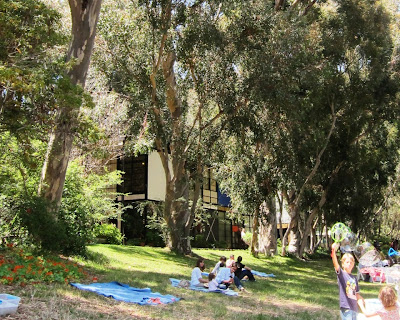It's simple - just two boxes facing one another across a patio, one a working studio for two talented designers, the other a residence.
It's modest - the residence is just 1500 square feet; the studio 1000. It was made with off-the-shelf materials, to be affordable. The designers wrote "The house must make no insistent demands for itself, but rather aid as background for life in work."
From Christmas Eve, 1949 and for the rest of their lives, Charles and Ray Eames lived in the house they designed. Ray died in 1988. The house has been kept by their grandchildren exactly as Ray left it.
We visited the house two years ago, and you can read my earlier post about it HERE.
When you think about modern architecture and modern furniture, it's easy to stereotype it as sleek, cold, and inhuman. But the Eames' approach to modern living was anything but. Houses were designed to accommodate work and play, at an affordable cost. They were fascinated with science, nature, and other cultures. Collectors of objects and images, the Eames gathered thousands of beautiful objects. Ray Eames created arrangements that were pleasing to her - whether on the kitchen table, on living room shelves, or in the garden. You can see one of these "shelfscapes" HERE at the Library of Congress. Her garden was as important to her as the house - the potted plants in the patios are arranged as she arranged them.
 |
| click to "embiggen" |
This photograph by Julius Shulman, from the Library of Congress, shows the Eames in their double-height living room. The room looks very much like this today. The seating nook with built in couches is a warm and cozy hideaway, piled with pillows and soft throws, while the main part of the room is soaring and filled with light, opening onto a sheltered patio.
You can see that they incorporated warmth, fabrics and texture, plants, toys, books and objects into their daily life, belying the stereotype of modern architecture as cold, empty, and uncluttered.
 |
| Eucalyptus trees on the site |
Candlesticks in blue, yellow and green glass
Blue onion plates
Oranges cut like flowers
A china figurine of two birds
Salt cellars
Small pillows in checkered fabric
A cookie tin
Books stacked on a bentwood chair
Japanese wooden dolls
Kites
Shells
Cowries
Balinese carved masks
African violets in pots
Abalone shells
Ficus trees
Ferns
A gold-topped coffee table
Pillows made of quilted blocks
Brass bowls
Carved wooden animals
Kachina dolls
A stuffed toy elephant
Polished stones
Indian corn in a basket
A feather fan
Crystal faceted spheres
Pine cones
Walnuts in a basket
Tumbleweed hung from the ceiling
A walrus carved from dark wood, with ivory tusks
Vases with snapdragons, lilies, and ranunculus
If you're in Los Angeles and you want to see the Eames House, you can make an appointment through the Eames Foundation. Regular visits of the grounds are scheduled by appointment, with a $10 admission fee. Some people enjoy simply visiting the site, lying on a blanket in the meadow, and reading a book.
Visits to the house do not include a tour of the interior. These tours occur once a year, on Member Appreciation Day in June. But soon, there will be another way to see how Charles and Ray lived, inside the house Charles once decribed as "life in a Chinese kite."
We learned that in the fall of 2011 as part of the upcoming Los Angeles art event Pacific Standard Time the contents of living room of the Eames House will be carefully moved to LACMA and recreated as an exhibit. This will give a wider audience the opportunity to see this "space for living," and give the Eames Foundation a chance to repair and restore the living room's floors.
Learn more about the Eames' work at this great Library of Congress site.





1 comment:
I love the pictures!
(Although you know me, I like the trees more than the buildings ;)
~
Post a Comment